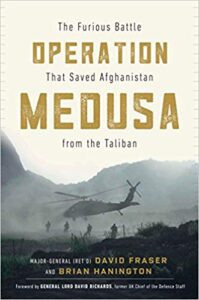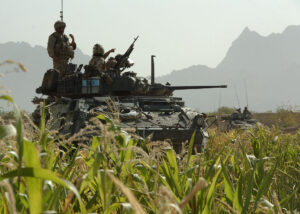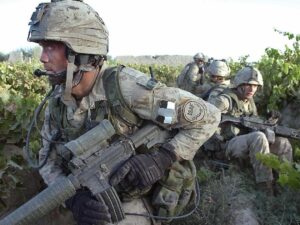Operation Medusa the Furious Battle That Saved Afghanistan From the Taliban Review

Major-General (Ret'd) David Fraser and Brian Hanington, Operation Medusa: The Furious Battle that Saved Afghanistan from the Taliban (Toronto: McClelland & Stewart, 2018).
~ ~ ~
Several Canadian soldiers have written first-class accounts describing their wartime experiences, some of which have become minor classics. On the other hand, the recounting of battles past Canadian generals who were in command is a distinct rarity. Nearly of them are to be found in lengthy memoirs, the quality of which varies greatly. Such narratives range from turgid prose that imparts footling to our overall understanding of events to highly informative accounts that provide overarching analytical insights. And, in any case, earlier getting to descriptions and discussions of combat, the reader is frequently subjected to many pages of text.
Well-nigh military machine history afficionados would likely exist aware of memoirs past LGen "Tommy" Burns[1], MGen Chris Vokes[2], MGen George Kitching[3], LGen Howard Graham[four], MGen Lew MacKenzie[v], LGen Romeo Dallaire[6] and Gen Rick Hillier[7]. Dedicated history buffs might even be familiar with some of the more than obscure entries, such as those by MGen Neb Griesbach[8], LGen Maurice Pope[nine], BGen Jim Roberts[10], Gen Jean Allard[11], and a recently-discovered one past MGen Ed Morrison of the First Globe War[12].
MGen David Fraser is the latest senior officeholder to contribute to this brusque list—and it is definitely a stimulating read. Although Operation Medusa: The Furious Battle that Saved Transitional islamic state of afghanistan from the Taliban is not a "whole-life" memoir, information technology continues the tendency started past MacKenzie, Dallaire and Hillier in chronicling command in combat in less-than-total-war situations—a distinction that might be lost on the soldiers fighting and dying in those conflicts.
And it is unique: the only book-length account of a single battle written by the Canadian full general in accuse. This functioning, which ran from early to mid September 2006, has been described in print before, most notably by the tardily journalist Adam Day in his excellent three-part series in Legion Magazine[13] and by Colonel Bernd Horn in his book No Lack Of Courage: Functioning Medusa, Transitional islamic state of afghanistan[14]. Significantly, first-person recollections of four soldiers decorated with the Medal of Military Valour for their actions during the opening stages of Operation MEDUSA are presented in Craig Leslie Mantle's In Their Own Words: Canadian Stories of Valour and Bravery from Afghanistan, 2001-2007[15].
Fraser—a brigadier general at the time—had been commander of NATO's Regional Control South in Afghanistan since February 2006. That summertime, he received intelligence that Taliban forces were massing preparatory to a full-calibration ground assault confronting the alliance's troops. It would be the biggest battle in NATO'due south history.

Photo credit: Flickr
The Taliban definitely had the home field advantage. Centred on the Panjwayi District—coincidentally the birthplace of the Taliban almost iii decades before—the enemy knew the terrain intimately, had highly-trained fighters at its disposal, had stockpiled critical commodities and had gear up countless landmines and IEDs. Decadent local officials who passed on information about Canadian soldiers' locations and movements—and even intentions on some occasions—protected Taliban fighters. The terrain also conspicuously favoured the defender.
Compounding Fraser'due south problem was the fact that his troops had just arrived in theatre—and had never been tested in combat. Add to the mix multi-national troops and assets; multiple chains of communications and control; language differences; and national restrictive caveats, and one can begin to empathise the enormity of the problem that he faced.
Things were non looking good.
Fraser and his co-writer, veteran writer Brian Hanington, divide the story of Operation MEDUSA—the codename for the campaign to attack and defeat the Taliban in Panjwayi—into two books. The get-go lays out the well-nigh year-long prelude to the boxing ("The Run-Up"), while the 2d details the two weeks of combat that followed ("The Battle"). Descriptive one-word titles for each chapter cleverly capture its essence: "Report," "Engage," "Programme," "Strike," "Drain," and "Slaughter."
The Taliban'due south deportment in massing their troops were a clear break from their previous tactics. In fact, the situation bordered on the bizarre: unconventional troops were using conventional tactics against conventional forces, which then chose to adopt unconventional methods to defeat them—a clear example of how dissimilar the war in Afghanistan was from the potential conflicts for which NATO troops had been preparing for a couple of generations.
On 3 August, something different happened after a vehicle hit an IED. Taliban insurgents rose from comprehend and fired on the Canadians, killing four of them. This was the beginning fourth dimension an IED incident had been covered by fire. Fraser admits that something inverse that day, but for "a long fourth dimension nosotros couldn't effigy it out" (p.83). It took a while for the realization to hitting him that "they think they can trounce us" (p.84).

Photo credit: Ottawa Citizen
That was when Fraser understood that he had to figure out how to defeat a force that was digging in for a conventional battle, something he and his troops were not manned, equipped or armed to practice.
"This," he notes, "is how the crude planning of Operation Medusa started" (p.84). The net event was that, rather than launching a conventional ground attack, Fraser decided he would have to proceed unconventionally: watching, waiting, using a wide range of intelligence avails to find enemy insurgents and the full arsenal of resources at his disposal to kill them—preferably at a stand-off distance.
It is at this indicate that Fraser explains the book's subtitle ("The Furious Battle that Saved Transitional islamic state of afghanistan from the Taliban"). His reasoning goes thusly: if the Taliban won in Panjwayi, it would create a safe haven from which to launch time to come operations, isolate Kandahar, remove national control of the area and destabilize the Afghan government. Additionally, insurgent success would strengthen Taliban resolve, bolster recruiting, increase the menses of weapons from Islamic republic of pakistan and weaken the homefront resolve of NATO nations.
It could be argued that this is "a bridge besides far," by ascribing more to Operation MEDUSA than information technology could or actually did accomplish. While it is obvious that Afghanistan has not (all the same) been saved from the Taliban, Fraser maintains that the operation did accomplish that goal at that particular time.
This discussion leads into the 2nd book, which is nearly one-third of the full. It describes the actual fighting in vivid, visceral, no holds barred detail. This department alone is worth the cost of admission. Time and time again, it illustrates the erstwhile war machine aphorism that "no plan survives contact with the enemy."[sixteen] Information technology held as truthful for Fraser and his forces equally it did for generations of their warrior predecessors.
A number of common threads run throughout the book. It appears that fifty-fifty in an age of mail service-modern aymmetric warfare[17], certain lessons learned in previous wars remain valid. Amidst the key ones—backed up by first-hand prove from Fraser—are the crucial requirements for authentic intelligence and the vital importance of teamwork (both friendly and enemy). Sadly, i lesson learned several times in earlier wars had to be relearned at a price: the failure to appreciate the furnishings of arms and air battery on well-entrenched enemy troops.
Fraser also provides honest, critical analyses of the capabilities of the Canadian Armed Forces, its allies and the Taliban. Additionally, his heartfelt compassion for the wounded and the fallen shows through fourth dimension and fourth dimension again.
Quotations—some of them quite lengthy—from participants at all levels in the functioning are scattered throughout the book. They provide idea-provoking points of view from a range of rank levels and nationalities. Additionally, several photographs enhance the text, especially those with extended captions that tell a "mini-story" of their own.
Maps—an essential component of all expert military history writing—are provided in front and dorsum endpapers. Unfortunately, their dark colour schemes detract from the clarity they should portray.
The writing itself will appeal to both avid military readers and a general audience, not an easy task to accomplish. Despite some minor concerns (sub-title merits, map clarity), David Fraser'southward book is a well-written, engaging, idea-provoking, highly descriptive relate of the biggest battle involving Canadian soldiers since the Korean War. It is besides an all-likewise-rare and most welcome personal account by a Canadian general in control during combat.
NOTES
[ane] Due east.L.M. Burns, General Mud: Memoirs of Two World Wars (Toronto: Clarke, Irwin, 1970). This and subsequent bibliographic entries for memoirs refer to first editions.
[2] Chris Vokes, Vokes, My Story (Ottawa: Gallery Books, 1985).
[iii] George Kitching, Mud and Light-green Fields: The Memoirs of General George Kitching (Langley, BC: Battleline Books, 1986).
[four] Howard Graham, Citizen and Soldier: The Memoirs of Lieutenant-General Howard Graham (Toronto: McClelland & Stewart, 1987).
[v] Lewis MacKenzie, Peacekeeper: The Road to Sarajevo (Vancouver: Douglas & McIntyre, 1993). MacKenzie's Soldiers Made Me Look Good: A Life in the Shadow of State of war (Vancouver: Douglas & McIntyre, 2008) is more an autobiography than a memoir about senior command.
[6] Romeo Dallaire, with Brent Beardsley, Shake Hands with the Devil: The Failure of Humanity in Rwanda (Toronto: Random Business firm Canada, 2003).
[7] Rick Hillier, A Soldier First: Bullets, Bureaucrats and the Politics of War (Toronto: HarperCollins Canada, 2009).
[8] W.A. Griesbach, I Remember (Toronto: Ryerson Printing, 1946).
[9] Maurice Pope, Soldiers and Politicians: The Memoirs of Lt-Gen Maurice A Pope, CB, MC (Toronto: University of Toronto Press, 1962). Pope's time as a general was every bit a staff officeholder.
[x] J.A. Roberts, The Canadian Summertime: The Memoirs of James Alan Roberts (Toronto: University of Toronto Bookroom, 1981).
[xi] Jean V. Allard, with Serge Bernier, Mémoires du Général Jean Five. Allard (Boucherville, QC: Les Éditions de Mortagne, 1985). This book was later published in English equally The Memoirs of General Jean V. Allard (Vancouver: UBC Press, 1988). Allard commanded the half dozenthursday Canadian Infantry Brigade for 45 days before V-E Day.
[12] MGen Sir Edward Morrison, Susan Raby-Dunne, ed., Morrison: The Long-lost Memoirs of Canada'southward Artillery Commander in the Great War (Victoria: Heritage House, 2017).
[13] Adam 24-hour interval, "Operation Medusa: The Boxing for Panjwai, Role one-The Charge of Charles Company" (Sep-October 2007); "Part two-Expiry in a Free-burn Zone" (November-December 2007); and "Part iii-The Fall of Objective Rugby" (Jan-Feb 2008), Legion Magazine.
[14] Colonel Bernd Horn, No Lack Of Courage: Functioning Medusa, Transitional islamic state of afghanistan (Toronto: Dundurn, 2010).
[fifteen] Craig Leslie Curtain et al., eds, In Their Ain Words: Canadian Stories of Valour and Bravery from Afghanistan, 2001-2007 (Kingston: Canadian Defence Academy Printing, 2013), Chapter 8, 191-230.
[sixteen] Usually attributted to Helmuth von Moltke, but also accredited to a variety of other strategic thinkers including Carl von Clausewitz, Napolean Bonaparte and Sun Tzu, amongst others.
[17] The Canadian Armed Forces defines disproportionate threats as "attempts to circumvent or undermine an opponent'south strengths while exploiting his weaknesses, using methods that differ significantly from the opponent's usual mode of operations." As quoted in Patrick Henrichon, "Protecting the Canadian Forces against Asymmetric Threats," Canadian Military machine Periodical iii, no. 4 (Wintertime 2002), x.
~ ~ ~
Retired colonel John Boileau served in the Canadian Army for 37 years. He allowable Lord Strathcona's Horse (Royal Canadians), taught at the British Army Staff Higher, was Chief of Staff at Atlantic Militia Area/Country Force Atlantic Surface area (now 5th Canadian Segmentation), and served as Regular army Adviser at the Canadian Loftier Commission, London. He is a graduate of the United States Army Armour Officeholder Advanced Course, the Canadian Forces Control and Staff College and the Imperial College of Defence force Studies. He is the author of 13 books of historical non-fiction (seven of them armed forces history), besides as more than 500 magazine and paper articles, book reviews, travelogues, encyclopedia entries and op-ed columns. He is currently Honorary Colonel of the Halifax Rifles (RCAC).
Source: https://cdainstitute.ca/boileau-on-fraser-and-hanington-operation-medusa-the-furious-battle-that-saved-afghanistan-from-the-taliban/
0 Response to "Operation Medusa the Furious Battle That Saved Afghanistan From the Taliban Review"
Post a Comment